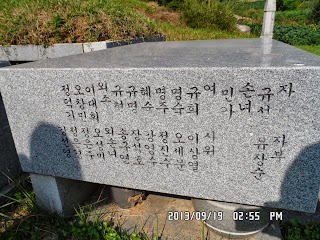Date: Sep. 19 (Thu) Chuseok Day, fine
Place: Cehongjeong-ri, Okcheon, ChungBuk province
Partner: Mrs. K and her husband
When I was working at InfoCom Research, a subsidiary company of NTT, I had been sent to ETRI from Oct. 1996 to Feb. 1997,
At ETRI, I came to know several people, including Miss K who was a grad student of Chungnam Univ.
She was working part-time as a Japanese translator at ETRI. I went to see a movie with Miss K and her friend, Miss N, and we went to a hiking to Mt. Daedungsan(大屯山대둔산) together.
Miss K invited me to her hometown at a countryside of Okchen, where her parents were living during “Seollal설날” (Lunar New Year’s Holiday) in 1997.
Miss K is the 5th daughter among 6 daughters of her parents. Mr. & Mrs. Lee had 6 daughters, but no son.
It was a special experience for me to observe Korean traditional holiday custom, and I stayed overnight at “Noinjeon(老人亭)” a house for old people in a village then.
I brought my mandolin and played the musical instrument for her family that night.
Later, Miss K graduated from Chungnam Univ., got married, and living in Daejeon with her husband.
I attended her wedding service, and I was told that her father was killed by accident and now her mother was living alone in the village.
Recently, I renewed our friendship through FB, and expressed my wish to visit her mother in Okchen, after 16 year absence.
Ms. K does not have a baby, instead she has a small pet dog named “Alkong.”
Ms. K and her husband picked me up at Shinseongdong by their car, and we headed for Okchen.
Since it was “Chuseok” holidays, there were many cars on the road. There was a heavy traffic jam on the highway between Daejeon and Okchen.
They picked me up at noon, and we arrived at her mother’s house at almost 2 pm.
The village did not change much, and I saw a renovated house at the same place.
I saw a big furnace at the corner of the garden. There were two big cooking pots on the furnace.
[Two set phrases of celebrating the first day of spring, 2つの立春を祝う四字熟語、입춘을 경축하는 사자 성어]
They used to have cows in cowshed, but no cow since her father passed away.
There were her 4th sister from Busan, and her mother in the house.
They treated me for lunch with “Chuseok” delicacies.
Then Ms. K and I went to the family cemetery.
It was at the side of hill, there were four tombs for two couples. A pair of tomb are for her parents, and another pair are for her uncle and aunt.
Right now, there was only her father under the tomb, other three are all alive.
But she said that her uncle had been hospitalized because of cancer.
However, they prepare tombs while people are alive. That is new to my knowledge.
After visiting the tombs, we left the village in Okchen to return to Daejeon.
On the way back to Daejeon, they took her 4th sister from Busan in their car.
They were visiting their uncle in a hospital in Daejeon.
Her 4th sister is wife of pastor at a church in Busan. In K’s family, her 1st and 4th and herself are Christians, as well as her husband.
Her 4th sister recently visited Japan, and she told me about her experiences in Japan.
I was happy that her experiences in Japan were mostly pleasant experiences. She got positive impression about Japanese people.
It was my 2nd visit on the countryside of Okcheon after 16 years absence.
I thought my experiences in Korea had rather long history.
Ms. K told me about her old friend Ms. N. Ms. N had be studying in Sendai, Japan, and got a job there. I would like to visit her in Sendai when I return to Japan next year.
-------------------------------------------------------------------------------------------------------------
分類:イベント
年月日:2013年9月19日(木)秋夕、晴れ。
訪問地:忠清北道沃川郡清亭里、Kの実家及び墓地
同行者:K夫婦
16年前の1997年2月7日、私は当時所属していたNTTの子会社InfoComから韓国の情報通信関係研究所(ETRI)へ短期派遣(96年10月-97年2月末)されていた。
この期間に、派遣先のETRIで知り合った忠南大学院生Kに誘われて、大田広域市の東側に接している沃川郡の山村、清亭里の彼女の実家を訪問した。
その日は韓国の名節(民俗的な祝祭日)であるソルラル(旧正月)で、親戚が一堂に会する重要な日であった。
Kは女ばかりの6人姉妹の5番目で、当時大学生であったKの妹が私に村を案内してくれた。
また、村はずれの丘にある先祖の墓地へ行き、家族による墓参りの儀式も見学した。
その日は清亭里の老人亭に布団を運んでもらい、一泊し、マンドリンを弾いたことも思い出す。
その後、Kは2002年に結婚し、その後、実父は事故で亡くなり、現在、実母が一人で清亭里の実家で暮らしている。
「秋夕(チュソク)」は日本の「お盆」によく似た祝日で、多くの人々が故郷を訪問するので「民族大移動」が起こる。
ただし、日本の「お盆」は公休日ではないが、秋夕はソルラル(旧正月)同様、前後を挟んで三連休となる。(今年は水曜日から金曜日だったので、週末をあわせて五連休だった。)
一般に都会に出ている人々が田舎へ帰り、ごちそうを食べ、お墓参りをするのだが、夫の両親を訪ねる方を優先するという。
今回、実母が一人で暮らす清亭里を訪ねたのは6人の娘たちのうち、子供のいない4番目(釜山の教会の牧師夫人)と5番目(K)だけで、残りの娘たちはおそらく夫の両親を訪れていたのだろうと推測する。
Kの実母には孫が11人いるという。
さて、今回はKの夫の運転する車で清亭里を訪ねた。
12時過ぎにKの夫がKと「アルコン"알콩"」という可愛い小犬(2歳のオス)を乗せて私を新城洞でピックアップしてくれた。
沃川郡は大田と接しているわけだが、清亭里へ行く直通バスはなく、3回乗り換えねばならないというので不便である。
この日は高速道路も渋滞し、清亭里の実家に着くのに1時間半要した。
村は16年前とあまり変わりはないようで、Kによれば小学校はとうの昔に廃校となり、その跡地はソウルの教会が購入して夏の修養会などに利用しているという。
Kの実家の門のまえにはカボチャの皮を薄く切ったものが干してあり、冬の料理に使うと言う。
また、門を入ってすぐ左側には大きな黒光りのする釜が2つ鎮座しているかまどがあった。
16年前に右側にあった牛小屋は小屋だけで牛はいない。
実家の裏は隣家のかなり大きな牛舎で牛の鳴き声や換気扇の音が聞こえる。
以前は茅葺であった家はトタン屋根の家に変わっていたが間取りは以前と大差はない。
以前は離れにあった木造のトイレは現在は母屋の一部になって、近代的な西洋式水洗トイレになっていた。
家の周りを見学しているうちに昼食の用意ができ、家の中に招かれた。「秋夕」の特別なごちそうは大田の方で用意していたというのできっと一番上の姉の家が大田市内にあるのだろう。
それでも私にはごちそうで、おいしくいただいた。「秋夕」に欠かせない「松餅(ソンピョン)」はKが作ったものだという。
昼食後、Kに案内されて両親の墓に連れて行ってもらった。
以前訪ねた同じ丘の斜面の近くに立派な墓が4基できていた。1組はKの両親のもので、もう1組は叔父夫婦のものだと言う。
実際にはKの父親のみ土葬されていて、他は現在すべて生きているのだが、あらかじめ準備してあるのだという。
Kの両親の墓は韓国で一般的な儒教式で、日本で見られるような墓石はない。
また、登山してよくみかける土饅頭ではなく、長方形で、前方に祭壇があり、祭壇には夫婦の家系と名前(夫は姓名、妻は姓のみ)が刻まれている。
また横には建立者(子供たち)の名前が刻まれている。
日本の墓は普通は「家」の墓であるが、韓国の墓は個人の墓であるところが大きな違いだ。
墓参後、我々より先に訪問していた四女は伯父を病院に見舞った後、夕方の列車で釜山へ帰ると言う。
叔父の入院先の病院は儒城にあり、まず、病院の前に四女をおろし、次に私を新城洞へ送ってくれた。
Kら夫婦は再び病院へ引き返し、叔父を見舞うのだろう。
Kの姉妹では一番上の姉と4番目の姉と本人(5番目)のみがクリスチャンだと言う
今回の訪問は16年ぶりの訪問だが、私も韓国の人々との縁もずいぶん長くなったものだと思う。
所で、16年前にKと共にETRIで働いていたKの友人のNは、その後、日本へ留学し、日本の大学を卒業後、そのまま日本で就職して住んでいると言うことを知った。
Nは仙台の大学を出て、仙台にいると言うので、私も来年日本へ帰国したら、一度仙台のNを訊ねてみたいと思う。
I like hiking very much. I used to go hiking with a Korean hiking club named “AhToSan.” This blog introduces mostly my hiking activities in Korea and Japan, and Sydney in Australia. As of January 2020, I live in Sydney suburb. I go Blue Mountains and bush walk in Sydney area. 私は2003年から2014年まで韓国の大田(テジョン)に住んだ日本人である。11年間、週末は主に「アトサン山岳会」に参加した。14年4月に帰国したが、2020年以降はおもにシドニーで暮らし、時折、日本へ帰国する程度である。したがって最近の記事はSR(Sydney Report)としてブルーマウンテンのトレッキングを中心に書いている。
About pictures/当ブログ内の写真について/당 블로그내의 사진에 대해서
Most of the pictures in this blog are taken by my camera, yet some of them were downloaded from the website of the hiking club. If you click any pictures, they become the original size.
当ブログ内の写真の大部分は筆者のカメラで撮影したものですが、一部、山岳会の共有写真からダウンロードしたものを含みます。すべて、各写真をクリックすれば、元のサイズに拡大します。
당 블로그내 사진의 대부분은 필자의 카메라로 촬영한 것입니다만 일부 산악회 공유 사진으로부터 다운한 것도 포함합니다. 모두 각 사진을 클릭하면, 원래 사이즈에 확대합니다.
当ブログ内の写真の大部分は筆者のカメラで撮影したものですが、一部、山岳会の共有写真からダウンロードしたものを含みます。すべて、各写真をクリックすれば、元のサイズに拡大します。
당 블로그내 사진의 대부분은 필자의 카메라로 촬영한 것입니다만 일부 산악회 공유 사진으로부터 다운한 것도 포함합니다. 모두 각 사진을 클릭하면, 원래 사이즈에 확대합니다.
登録:
コメントの投稿 (Atom)

































0 件のコメント:
コメントを投稿